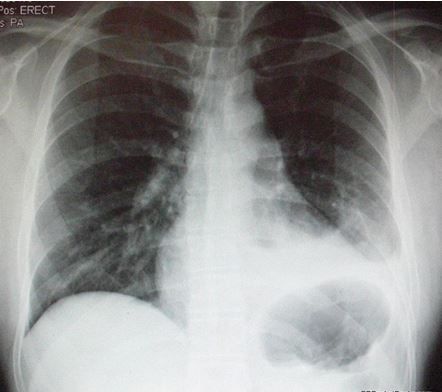Chest Pain After Hemopneumothorax
Recovery from a hemopneumothorax had progressed well for this 29-year-old man until today when he presents to the ED with dyspnea and pleuritic chest pain. What do you see on the chest x-ray?
Figure. Click to enlarge image.

A 29-year-old man presents to the emergency department (ED) with dyspnea and pleuritic chest pain. He was hospitalized 2 weeks ago for a stab wound to the chest. He required a chest tube for a hemopneumothorax. He states that he had been improving day by day at home since his release more than a week ago until today when his symptoms suddenly worsened. He says he had stopped taking his pain pills many days ago, but today he started again and has only 5 pills left. He denies any fever, recurrent trauma, hemoptysis, or other complaints.
On physical examination his vital signs and pulse-oximetry are all normal with pulse, 88 beats/min; temperature, 37.1°C (98.8°F); blood pressure, 130/83 mm Hg; and oxygen saturation, 95% on room air. His head and neck examinations are also normal without JVD, but he has decreased breath sounds on the symptomatic left side, the side on which he sustained the stab wound. The wound looks mostly healed without evidence of infection. His heart beat is regular with normal heart sounds. His abdomen is non-tender and his legs show no redness or swelling.
Suspecting a recurrent pneumothorax, a chest x-ray is ordered and is shown in the Figure. The radiologist reads it as negative for pneumothorax and unchanged from the discharge chest x-ray of last week. You contact the trauma surgeon who originally took care of the patient and he comes to the ED for a consult. He recommends that you discharge him home with a refill of his pain medication.
Do you agree with this decision?
If not, what condition might you and the surgeon be missing?
Please leave comments below.
For answer and discussion, CLICK HERE.